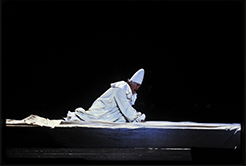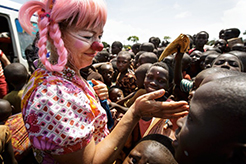by Philippe Goudard
Born on stage, developed in the ring, dematerialised on the screens, the poetic, political and spiritual power of clowning allows a transference from the figure to the works of other artists.
Clowns transfers
The deep fascination with the circus arts is matched by a considerable literary production where the clown is king, from the Hanlon-Lees to Foottit and Chocolat, Annie Fratellini or even Slava Polounine. Novels, chronicles, plays and scripts, memoirs, biographies and essays offer clowns another life under the pen of poets, chroniclers and historians. Baudelaire, the Goncourt brothers, Jean Cocteau, Arthur Miller, Gérard Noiriel, and so on, it is a long list indeed. Among them, Félicien Champsaur, journalist and novelist, will contribute to changing the social discourse in response to the rise of feminist demands at the end of the 19th century, with his erotic novel Lulu featuring a clowness, just like the one painted by Toulouse-Lautrec, Cha-U-Kao, who was a boisterous entertainer at the Moulin Rouge. These symbols of bourgeois male fantasies of the time paradoxically contributed to the opening of the clown world to women.
Musical comedy performances are present among instrumentalists such as Grock or the Rastelli, or more recently, by the French music-hall ensemble Le Quatuor. But Rigoletto, the tragic clown of Giuseppe Verdi and Francesco Piave inspired by Victor Hugo, or I Pagliacci by Ruggero Leoncavallo, bring the clown to the opera and place the transgressive or marginal figure at the dramaturgical heart of the works.
Clowns are found in modern and contemporary visual arts from Francisco de Goya to Alexandre Calder and beyond. Among a large number of major works inviting clowns, Georges Seurat shows their vitality in the ring, colourful and sinuous against the backdrop of a static and cold audience. Marthe and Juliette Vesque, both naturalist watercolour artists, studied their acts during the first half of the 20th century and left us a meticulous trace, like Jules Chéret, the poster artist. Their stunts and falls are all metaphors for the risk of death and their portraits seek the meaning of life. Toulouse-Lautrec, Pablo Picasso, Bernard Buffet and the psychedelic clowns personified by Cindy Sherman, who questions the roles of the North American woman, challenge us on the hidden face of the clown, opening the way, like the film industry, to a metaphysical exploration of the clown, which takes into account the artist's and public concerns, then reconnecting it with the Prince, as was the case with Lear in Feste. In this vein, Samuel Beckett's Film, starring Buster Keaton in 1965, paves the way for some of the works of the new generations of clowns.
In the graphic field, comic strip characters such as Gaston Lagaffe are also probably clownish transfers.
The socio-economic path
Some contemporary forms of the clown return to his original social function. Far from the spotlight, it is within the different sectors of activity of civil society or institutions that today's clowns are stepping into new fields and meeting new audiences. They educate and care, are educational assistants or even in the leisure or cultural industries.
In our rather pessimistic and anxious societies, the benefits of laughter are very powerful. Associations such as Le Rire Médecin or Les Blouses Roses at Robert Debré Hospital in France offer their services in hospitals and mainly in paediatrics. Clowns Without Borders works with victims of conflicts or humanitarian disasters. The female Colombian clowns of Ana Velasquez contribute to the reduction of violence on the streets of Medelin, as well as the social circus contributing to the reintegration of the most deprived people all over the world. Clownesque acting courses offered by professionals contribute to the well-being of employees, the training of actors as well as the education of social workers. The educational and artistic values of the clown figure help teachers. The empathy associated with the image of the clown is an additional factor in the consumption and enjoyment of many cultural and non-cultural products. These various roles occupied by today's clowns testify to the universal scope of the figure and its functions, which go far beyond the ring, far beyond the performance in any show.









